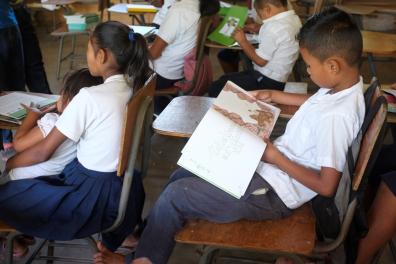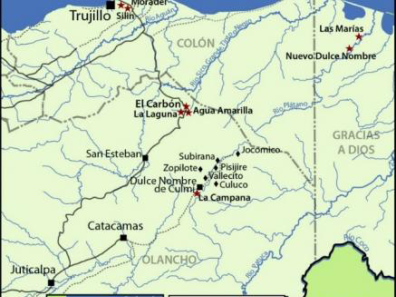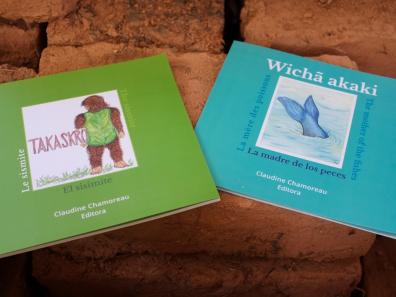Documentation of the Pesh language spoken in Honduras
Linguistic documentation is fundamental to the knowledge of indigenous languages, and even to their preservation if certain conditions are met, in particular the willingness and involvement of community members in the documentation project. This experience will be illustrated in this article through the project to document the Pesh language spoken in Honduras.

The Pesh language spoken in Honduras
Pesh (pech, paya, ISO 639-3Pay) is the northernmost of the 16 living Chibcha languages and the only one spoken in Honduras. Pesh is threatened with extinction: there are around 500 speakers, 80% of whom are over 60. The language is spoken in fourteen villages. The map shows the regions where Pesh is spoken; the stars indicate the eight villages where data was collected. There are three dialects in total: the Carbon dialect, spoken in Carbon, La Laguna and Agua Amarilla by around 280 speakers; the Las Marias dialect, which is spoken in Las Marias by 5 speakers; and the Culmi dialect, which is spoken in the remaining ten villages by around 220 speakers. There is little information in the literature on Pesh. A 1928 overview contains a list of Pesh words translated into Spanish (Conzemius, 1928). More recently, Holt (1999) has published an incomplete synthesis of the grammar.

The Pesh documentation project
A major Pesh language documentation project was submitted in 2013 to the Hans Rausing Endangered Languages Programme (ELDP). It was accepted and ran from 2014 to 2017. This project has three main objectives: the collection of more than thirty hours of stories and conversations in Pesh transcribed and annotated on the ELAN program as well as the analysis of the data, the writing of scientific articles and a grammar in the medium term (within about 5 years); then the publication of glossed, analyzed and translated texts illustrated with photos. The project is run by 11 members: 5 members of the Pesh community, who collect data, transcribe and translate them using the ELAN program; 4 linguists, who refine the transcriptions and analyze the data; 2 anthropologists, who film the work and study the use of plants in traditional medicine and cooking recipes. To date, we have collected 290 documents (179 videos and 111 audios) and provided metadata for each speaker and document.
All this data can be accessed on the project page (https://www.elararchive.org/). Team members are now continuing the work to refine and complete the data.
The project to publish the first books written in Pesh
About 6,500 languages are spoken in the world. According to Unesco, 96% of them are spoken by only 4% of the population, and by the end of the 21st century, around 90% of these languages will have disappeared. Around 95% of languages are unwritten. Such is the case of Pesh, a language of the Chibcha family spoken by fewer than 500 people in Honduras and threatened with extinction.
During the documentation project, the participatory approach of researchers in various communities and the awareness of speakers of the danger of extinction of their language led them to engage collectively in actions aimed at creating and publishing the first storybooks in this language, which had never been written before.
Many members of the Pesh community became actively involved in the project and expressed the need to publish books in their language in order to strengthen and disseminate their cultural traditions and to develop teaching materials for teaching the language, as these were non-existent. This need emerged during the course of the project, and the first two books written in Pesh are the result: they will be useful both within the Pesh community and in society at large. They have been written for the community and for anyone interested in the Pesh language. Funding from the Endangered Language Documentation Programme (ELDP), the Laboratoire d'Excellence "Fondements Empiriques de la Linguistique" (LABEX-EFL), Sorbonne Paris Cité University (USPC) and the Center for Mexican and Central American Studies (CEMCA) made these publications possible.
For the first publication, we chose the tale Wichã akaki "The Mother of the Fishes" because it has been told repeatedly by speakers from different villages and occupies an important place in the Pesh tradition. It's a founding myth of the Pesh people, in which a mermaid lures a man underwater to unite with him. For the second publication, we chose the tale Takaskro "The Sisimite", another well-known myth central to the Pesh tradition. This famous Central American myth is also known by its Nahuatl name as tzitzimitl. The sisimite is described as a hairy monster with human-like characteristics. He kidnaps women to take them to his cave and unite with them.
These tales are written in Pesh and translated at the end of the book into Spanish, French and English. A paper version (published in 500 copies, one for each language speaker) and an active audio version are available for both tales (http://www.cemca.org.mx/wicha-akaki/ and http://cemca.org.mx/takaskro/). Two new tales will be published in 2019, also funded by the same institutions as the first books.

The documentary "What came out of us came back written"
The documentary "What came out of us came back written" describes the impact of linguistic research carried out in communities where Pesh is spoken. It illustrates three stages of the projects carried out: the documentation of the language and culture; the creation of the publishing project and publication of the first books in Pesh; and finally it shows the reception of the works in different communities. Based on an idea by Claudine Chamoreau, the documentary was filmed by a professional director, Ludovic Bonleux, who also has a passion for anthropology and sociology.
The documentary offers both a local and global view, from speakers, researchers and education officials alike. It provides an insight into the symbolic and identity-building power of a language, its entry into the written word, and the breakdown or reorientation of its transmission. Funding from ELDP, LABEX-EFL, USPC and CEMCA made this documentary possible.
It is freely accessible on the internet in 3 versions:
- Spanish: "Salió de nosotros y regresó escrito. Documentación de la lengua pesh" [https://youtu.be/fmDiFW5Mrrc - https://vimeo.com/228396358]
- French: "Ce qui est sorti de nous est revenu écrit. Projet de documentation de la langue pesh" [https://youtu.be/z3flvMwx0yo - https://vimeo.com/243014857]
- English: "What went out from us has come back written. Documentation Project in the Pesh language" [https://youtu.be/BBNvI_DuDK8 - https://vimeo.com/248377767]
Some bibliographical references cited:
- Conzemius, E. 1928. Los Indios Paya de Honduras. Estudio geográfico, histórico, etnográfico, y lingüístico. Journal de la Société des Américanistes 20: 253-360.
- Goddard, Ives (ed.). 1996. Handbook of North American Indians. Volume 17: Languages. Washington: Smithsonian Institution.
- Holt, Dennis. 1999. Pech (Paya). Munich: Lincom Europa.
Scientific contact : Claudine Chamoreau, CNRS research director, SeDyL laboratory
View e-mail